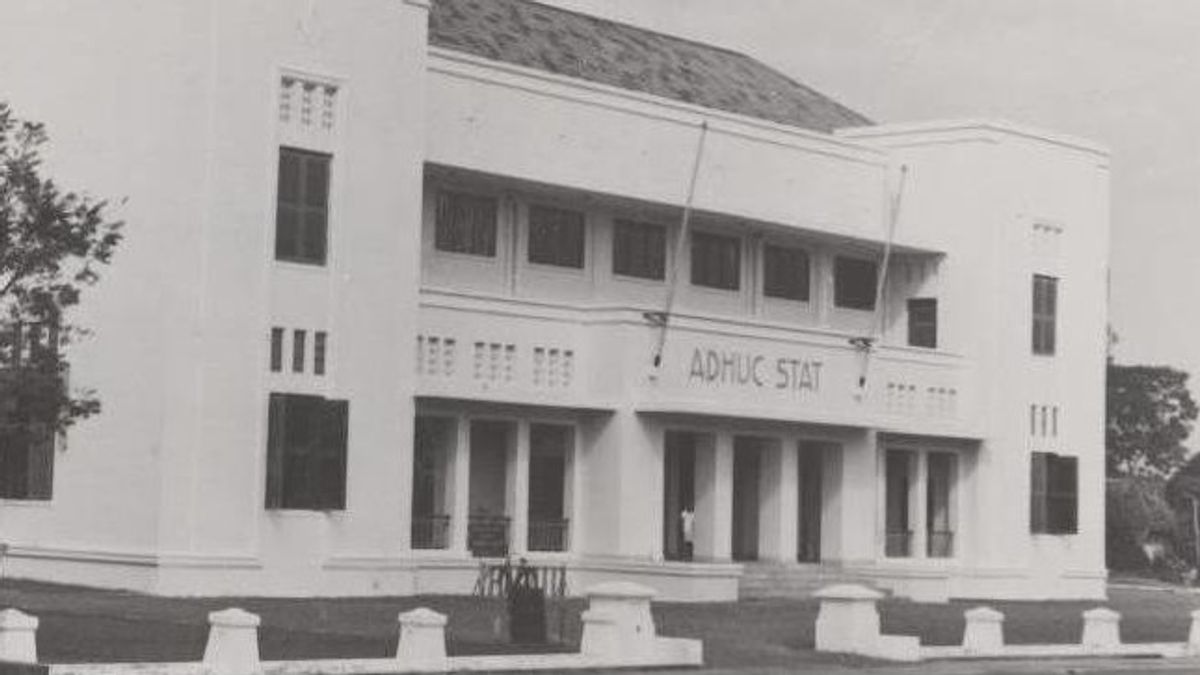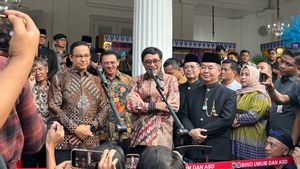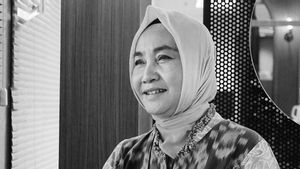JAKARTA - Long before Indonesia's independence, the Freemasons association had become the most famous organization in the Dutch East Indies. This can be seen from the regular meetings held by its members. They also called the meeting place a loji. Uniquely, local people often refer to the loji as the devil's house. One of the devil's most famous houses at that time was the Bappenas Building in Menteng, Central Jakarta.
Based on history, the Bappenas Building or the Adhuc Stat Building was one of the 25 lodges that were recorded as being present in Jakarta until the 1930s. The Adhuc Stat building is truly special. This building was built by the architect Ir. FJL Ghisel under the name of the architectural and contractor bureau Algemeen Ingenieurs en Architecten Bureau (AIA) in 1925.
"This is a former logegebouw, the special position of the loji association hall in the Menteng layout shows the important position of vrijmetselaar (Freemason members), an international organization that keeps some of its activities secret so that it gets a big influence," said Adolf Heuken SJ and Grace Pamungkas in the book Menteng: Kota. First Park in Indonesia (2001).
Architecturally, Adhuc Stat shows a strict architecture. The center that extends and compensates for the vertical direction is flanked by two sturdy solid towers. “The strong impression is underlined by the longitudinal roof which is not high enough. The arrangement of the windows in a row, all of which are rectangular, lightens the face a little, ”said Adolf.
The Loji establishment located near Burgemeester Bisschopplein - present-day Suropati Park - is another specialty. The name Bisschop itself is taken from the name of a member of the Dutch East Indies Freemason who was also the first mayor of Batavia (1916-1920). In addition, this park has even become a place where Batavian residents spend their vacation time.
Lush trees and cool air make this area always crowded. Like it or not, many people who are on vacation in the park are curious about the activities of the members of the Freemasonry of the Indies-Netherlands. Regarding Burgemeester Bisschopplein, we briefly reviewed it in the article "Knowing Taman Suropati, Jakarta's Lungs Since the Company Era" .
As a result, rumors began to emerge among the public that a ritual was often carried out in this building. One of the most talked about rituals is séance. From there it is embedded in the minds of the people that the loji is the house of the devil.
In fact, the activities of Freemasonry members are not only ritual in nature. In every meeting that is religious in nature, the members often discuss philosophy, societal problems, and social-economy. As revealed by Dr. Th. Stevens in the book The Free Mason Order in the Dutch East Indies and Indonesia 1764-1962 (2004), this association can be the starting point of the thought that believes that no human being is perfect.
"By cultivating himself, man can become a man with better ideals, a pure cube, hidden in his own form and just waiting to be released," said Stevens.
As a library
Besides functioning as a meeting hall, the loji also functions as a volksbibliothek or people's library. Firman Lubis quoted in the book Jakarta 1950-1970 (2018), a large room in the Adhuc Stat Building in the first half of the 1950s was used as a library.
"It seems that the custom of opening this library is a remnant of the colonial era by private organizations. Because I really enjoy reading and this library is not far from my house, I became a member of it and often go to this library to read and lend books at home, ”said Firman Lubis.
Firman also explained a rule, that the number of books borrowed should not be more than three in one loan. After borrowing, Firman then read some books at Taman Suropati. The rest is continued at home. As far as he can remember, the books available in the Adhuc Stat library are quite complete and good. Most of them come from Balai Pustaka or Dutch publishers that are still operating in Indonesia, JB Wolter.
"For example, the books written by Sutan Takdir Alsjahbana, Nur Sutan Iskandar, Abdul Muis, Sanusi Pane, Armijn Pane, Selasih, and others. Also translated into Indonesian, such as the works of Shakespeare, Moliere, Mark Twain, Karl Mat, Alexandre Dumas, Cervantes, books by Tolstoy, Chekov, BebVuyk, and many other famous authors, "Firman.
The library was quite popular and loved by young people at that time, because schools in Jakarta did not yet have libraries. Then, with the presence of the library in Adhuc Stat, everyone can become a member and access a lot of literature that can open horizons of thought.
So the Bappenas Building
The Adhuc Stat building finally changed its function, like many other historical buildings in Menteng. For example, the Kunstkring Building and the Boplo Building, each of which we reviewed in "Memories of the Kunstkring Building as the Palace of Art in the Dutch East Indies Period" and "The Boplo Building, a Dutch-Owned Building Now Transformed into Cut Meutia Mosque" .
Slowly, Freemason associations in Indonesia disappeared. The peak point is believed to be 1961. The association has recorded 200 years of presence in the archipelago. Soekarno, who was then in power, felt that the association was not in accordance with the ideals of independence.
This prohibition resulted in the conversion of the Adhus Stat Building to the Office of the National Planning Council. Then, it became a military court that tried the figures of the September 30th Movement (G30S) in 1966. It was only then, in 1967 that the building completely became the Bappenas office until now.
For those who want to remember how great the Freemasonry was in Indonesia, they can come directly to Taman Suropati to have a close look at the Bappenas Building. At the same time, you can enjoy the coolness of "Menteng Exclusivity as the First Modern Residential Area in Indonesia" .
For the rest, one can recall how influential Freemason associations were on the Indonesian national movement. This can be interpreted through a poem by a Freemason member, Rudyard Kipling, entitled The Ballad of East and West (1889). Through this poem, people came to understand that this association was one organization that dared to embrace all social classes, regardless of skin color, then studied and discussed together.
O, East is still East, and West is still West,
Never did the two of them possibly meet,
Until the day when Earth and Heaven face
God's Judgment Chair,
But there's no meaning East or West,
Boundary, origin or origin
If two strong men stand facing each other
Even though they come from opposite ends of the world.
(fragment of the poem The Ballad of East and West).
The English, Chinese, Japanese, Arabic, and French versions are automatically generated by the AI. So there may still be inaccuracies in translating, please always see Indonesian as our main language. (system supported by DigitalSiber.id)













